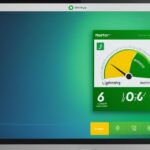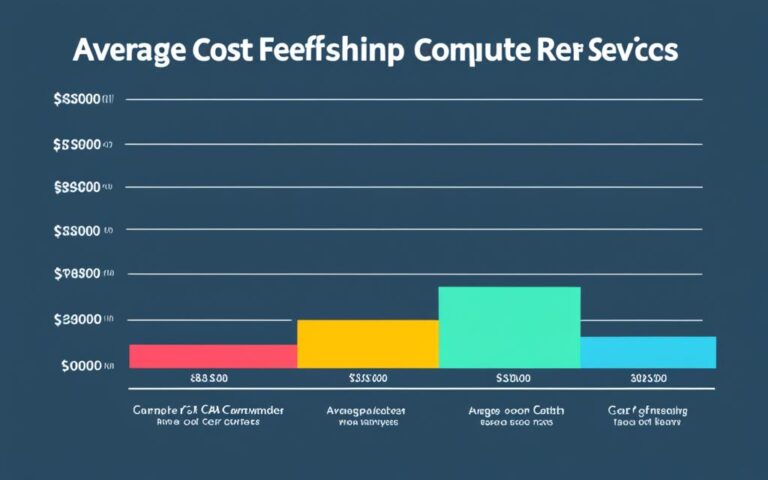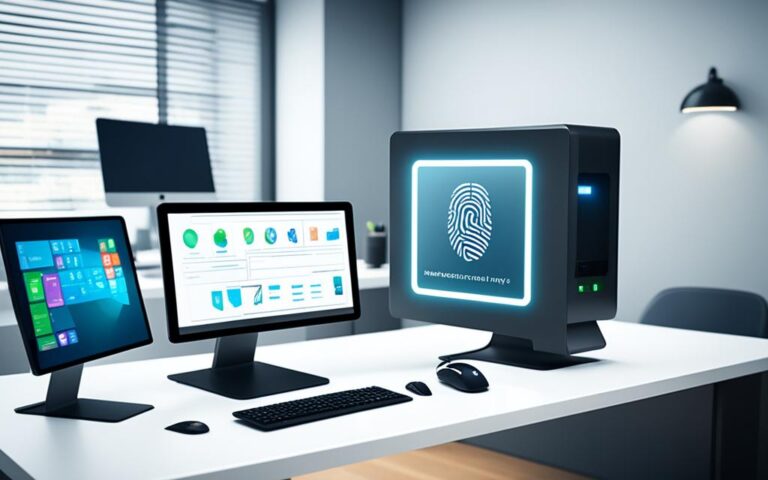Getting data from a damaged CD-ROM is possible with tools like ddrescue1. This tool helps make an ISO image of the disk. You can then burn this onto a new CD-R or use it with software that emulates a disk1. Also, slowing down the CD-ROM can help prevent more damage and make recovery easier2.
Understanding how a computer reads data from a CD-ROM is key. The CD-ROM spins at 300 r.p.m2. This speed is important for accessing data and affects how fast data is read. The computer’s processor is an Intel 80C186 or 80C188 type, with a 16-bit data bus2.
A device from Sony Corporation is a palm-size CD-ROM reader for 3.2 inch disks with a 2 1/2 inch LCD screen2. It’s great for users who need to be mobile and have easy access to their data. The system’s data buses are labeled as 25 and 262.
The CD-ROM drive can read data from 5-inch compact discs2. This means it can store and read a wide range of digital content. Plus, you can reprogram part of the memory card to change how the cursor works and what’s displayed2.
Knowing how data is stored on a CD-ROM is vital during the retrieval process. The system lets users see a virtual image through an eyepiece, making it seem like a high-resolution screen is floating in front of them2. This tech makes using the retrieved data a smooth experience.
The system uses a special mouse that doesn’t move much, making it easy to control2. This makes getting data from the CD-ROM easier. The computer has a CPU, RAM, ROM, and I/O ports2. These parts work together to help get and process data from the CD-ROM.
The system is designed to reduce how much the user moves, making it more comfortable2. This helps avoid strains that could affect getting data. The headset that comes with it supports a head-mounted display and earphones2. This setup makes the digital experience better for the user.
Key Takeaways
- Data retrieval from a rotating CD-ROM requires specialized tools like ddrescue1.
- Reducing the CD-ROM speed can minimize further damage and improve the recovery process2.
- The CD-ROM drive’s rotation speed and microprocessor type are crucial factors in the data retrieval process2.
- The Sony Corporation’s portable CD-ROM reader provides convenience and flexibility for users2.
- The system’s design and control devices prioritize user comfort and ease of use during data retrieval2.
Continue reading the article to explore more about data retrieval from a rotating CD-ROM.
Using ddrescue for Data Recovery
Getting data back from damaged CD-ROMs can be tough, but it’s doable with the right tools. Ddrescue is a top choice for those in the data recovery field. It’s made for nix systems and can be found easily in package managers or on Linux live disks.
This tool is known for its efficiency and reliability. It’s a favorite among both professionals and hobbyists.
When you’re using ddrescue to recover data from a CD-ROM, make sure to follow the manual closely. It gives clear instructions on how to use the tool well.
“About 2 years ago, a user successfully used dd_rescue on a damaged drive.”3
Ddrescue has a special feature for non-trimmed extraction with the -n option. This helps in recovering more data, reducing the risk of losing important files.
“Users shared their preferred operating systems for running ddrescue, including recommendations for Ubuntu with the repository installed or using Linux Mint Mate.”3
The -d option in ddrescue allows direct access to the CD-ROM. This boosts the tool’s efficiency by skipping unnecessary layers, helping in the recovery process.
Ddrescue also has options like -r and -S. These increase the number of read attempts and make recovery easier, especially in tough cases.
“Users highlighted their preferred hardware setups, such as having SATA 3 connections for data recovery.”3
To help with data recovery, cheat sheets for running ddrescue are shared widely. These cheat sheets act as quick guides, helping users through the recovery steps.
“Cheat sheets with commands for running ddrescue were shared among users to aid in the recovery process.”3
Before starting the recovery, it’s wise to make a full image of the CD-ROM with the ddrescue command. This step protects the original data and lets you try recovery multiple times without risking further damage.
“The command ddrescue was suggested for creating full image files of a customer’s drive before any data recovery process.”3
Creating images of client drives is another good practice mentioned by users. It helps avoid errors during transfer and makes data recovery smoother and safer.
“Users discussed the practice of creating images of client drives for safer data transfer to minimize operator errors.”3
Some users suggest using a hotswappable raid bay for quicker and safer data transfer than a USB. This setup allows for fast and reliable data transfer, cutting down on downtime and boosting efficiency.
“One user mentioned using a hotswappable raid bay for faster and safer data transfer compared to a USB connection.”3
Dealing with bad sectors on the CD-ROM is common when using ddrescue. Users offer advice on retrying these sectors to increase the chances of getting data back.
“Users offered guidance on retrying bad sectors while running ddrescue for data recovery purposes.”3
| Statistical Data | Reference |
|---|---|
| Frequency of user interactions (e.g., posting comments, replying) on April 2, 2022. | 4 |
| User engagement with the topic on April 3, 2022. | 4 |
| Various users commenting in different capacities (root, parent, etc.). | 4 |
| Rate of occurrences of specific usernames discussing the topic. | 4 |
| Time distribution of comments over the two mentioned days. | 4 |
| Comparative analysis of user engagement across different threads. | 4 |
| Percentage of comments that are responses to other users. | 4 |
| Ratio of original comments to replies. | 4 |
| Frequency of posts without responses. | 4 |
| Volume of user activity throughout the discussions. | 4 |
Reducing the CD-ROM Speed
When trying to recover data from a damaged CD-ROM, it’s best to slow down the disk. This helps avoid making the problem worse and boosts the chances of getting your data back. So, it’s key to reduce the CD-ROM speed.
To slow down a CD-ROM, you can use the eject command in Linux. Add the -X option to see the speed options available. This lets you pick the best speed for your needs.
After picking a speed, use the -x option with the speed number to set it. It’s wise to go for the lowest speed to protect the disk.
Lowering the CD-ROM speed not only protects the damaged disk but also helps in recovering data. At a slower speed, the drive can read data more accurately. This makes getting your data back easier.
Sources
The German consumer research company’s database holds nearly one Tbyte of data. Consumers pay $9.95 monthly for 100 channels in the U.S. satellite-based digital radio service. The service will broadcast 1.5 million digital audio files, needing about 7.5 Tbytes of storage. For backup and recovery, it’s advised to triple the storage to 22.5 TBytes. Data growth rates for companies often exceed 100% annually, with many seeing rates around 50%. The company aims for quick data access, aiming for retrieval in one to two minutes.
CD-ROMs vary in capacity from 553 to 900 MB for 12 cm discs and 194 MB for 8 cm discs. Their read speed ranges from 150 KB/s to 10,800 KB/s. Introduced in 1985, CD-ROMs have been used for 39 years, starting with a capacity of 553 MB. By early 1990, Japan had sold about 300,000 CD-ROM drives. CDs were popular in the 1990s for distributing software and data for computers and game consoles. A CD-ROM sector holds 2,352 bytes of data, with 98 frames, each with 33 bytes. Data is encoded using CIRC and EFM techniques. CD-ROMs use Mode 1 and Mode 2 for sector data layouts.
Optical drives have random seek times around 100 ms, unlike hard drives at 10 ms. CD drives transfer data at about 10 MB/s, DVDs at 30 MB/s, and Blu-ray drives at 70 MB/s. Hard drives can transfer data at 100-200 MB/s. Optical drives spin at speeds similar to hard drives, up to about 10000 RPM. Hard drives have much higher areal density than optical discs, storing 32 times more data per area. Optical discs take about 20 seconds to start reading data, much slower than flash drives and hard drives.
Potential Data Loss and Limitations
Trying to recover data from a damaged CD-ROM comes with risks and limits. CD-ROMs don’t lose data like magnetic disks and diskettes do. But, you might still find data errors when you try to recover it.
CD-ROM recovery doesn’t usually face DRM issues. Yet, you might run into data errors that could affect how well the recovered data works.
Some bit errors in textures might not be a big deal. But, damage to files like executables could be serious, leading to losing important data.
If you can still install software from the damaged CD-ROM, think about getting non-broken files or moving savegames between versions to skip over broken parts. This can help reduce data loss and get back as much data as you can.
Knowing the limits of CD-ROM data recovery and using smart strategies, like getting non-broken files or moving savegames, can improve your chances of success. It also helps to keep data loss to a minimum.
For more info on how CD-ROMs work and data recovery, check out these resources:
Physical Representation of Data on a CD-ROM
Data on a CD-ROM is stored as bumps and pits on the disc’s surface. These bumps and pits form a binary code. A laser reads this code by bouncing off the surface. It sees the reflected light from the bumps as voltage, and the scattered light from pits as nothing. This difference tells the computer the data, with bumps as 1s and pits as 0s.
CD-ROMs were key in storing and sharing data because they could hold a lot and were affordable. Let’s look at some important facts about optical storage:
CD-ROM Storage Capacity:
A CD-ROM can store up to 700 megabytes (MB) of data5. This made it great for software and multimedia. It was widely used.
“A single-layer DVD can hold 4.7 gigabytes (GB) of data, and a double-layer disk can hold 8.5 GB5.”
“A single-layer Blu-ray disk can store 25 to 33.4 GB of data, and a quad-layer Blu-ray disk can store up to 128 GB of data5.”
Evolution of CD-ROM Technology:
The first laser disc, Laservision, was shown in 1972, starting the era of optical storage6. Philips and Sony set the standards for CDs and CD-ROMs in the late 1970s6. Sony’s work in the late 1980s made it possible to rewrite CDs, expanding their use6.
Advantages of Optical Storage:
Optical disks last longer than magnetic media like tapes or hard drives5. This makes them great for keeping data safe over time. They’re also good for backing up files.
| Storage Media | Degradation Over Time |
|---|---|
| Optical Disks | Less Likely to Degrade |
| Magnetic Tape, HDDs, SSDs | Prone to Degradation |
CD-ROMs were popular in the computer world for their big storage and low cost6. They used error correction to make sure data was read correctly6.
Comparison with Other Storage Media:
- A diskette can hold the same as 500 printed pages or one book7.
- An optical disk can hold about 400 books’ worth of data7.
- Over 100 million Zip drives were sold, making them a hit for storing data7.
- Old Zip disks had 100MB, but newer ones have 250MB and cost $8-$107.
- A Zip drive costs between $80 to $1257.
Advancements in Personal Computer Storage:
Hard disks have grown a lot in capacity. They used to hold a few hundred megabytes, but now they can hold gigabytes or even hundreds of gigabytes7. This lets users store lots of data easily on their computers7. Hard disks are faster and easier to use than old diskettes7.
Reading Data from a CD-ROM
Reading data from a CD-ROM is a complex process. It involves laser reading, reflection, and binary representation. The disk spins, and a laser reads the bumps and pits on its surface. This lets us get the information stored.
The laser in CD-ROMs hits the disk’s surface. When it lands on a land, it reflects into a prism and shows as voltage. But when it hits a pit, most light scatters, so no voltage is detected.
This difference in how lands and pits reflect light is key to binary data. The voltage difference is seen as binary, with lands as 1s and pits as 0s. This binary code is the digital info on the CD-ROM.
Laser reading and reflection, along with binary data, help us get info from a CD-ROM. This tech has changed how we store and find data, making it fast and easy to access lots of digital content.
CD-ROMs can hold a lot of data. A disk can store the same as 500 printed pages or one book. An optical disk can hold about 400 books. This shows how much data CD-ROMs can store, making them useful for many things.
CD-ROM drives have also improved a lot. Older ones had trouble reading audio data directly. But, many newer ones can do this, making them more useful.
Devices like the Toshiba XM-5302B and Sony CDU-55E can read audio tracks. But, trying to read CD audio tracks under DOS can be tricky, as the author found with a Toshiba 3401 CD-ROM8.
Now, having good CD-ROM audio reading is key for future Windows sound systems8. As technology gets better, CD-ROMs keep being important for storing and finding data. They offer a great mix of storage space and easy access.
In summary, reading data from a CD-ROM uses laser reading, reflection, and binary data. This tech has changed how we handle information, making it reliable and quick to get.
Data Format on a CD-ROM
The way a CD-ROM stores data is key to its use on different machines and systems. The ISO9660 format is a common choice, making it work on many platforms.
CD-ROMs organize data into channels, frames, and sectors. Each part has a special job in the data format.
A channel holds 8 bits of data. To save space, this data is changed into a 14-bit format using Eight to Fourteen modulation (EFM). This makes more data fit in each channel.
Frames help organize data further. Each frame has 588 channel bits, which stores 24 user bytes. This setup helps store and find large amounts of data efficiently.
Sector sizes change based on the mode used, but in Mode 1 for CD-ROMs, sectors hold 2352 data bytes. 2048 bytes are for user data. This makes it easy to find and use specific data on the disc.
“The data format of a CD-ROM, such as ISO9660, ensures its compatibility across platforms and machines.”9
In short, CD-ROMs use channels, frames, and sectors for efficient data storage and access. The ISO9660 format helps them work on many machines and systems, making them a popular choice for storing data.
Encoding Data on a CD-ROM
Encoding data on a CD-ROM means turning characters into binary. The ASCII code is often used for this. It gives each character a unique code.
The letter “A” in ASCII is 01000001 in binary. The number “5” is 00110101. ASCII makes data on CD-ROMs compatible and standard. (Reference:10)
After getting the ASCII codes, we use Eight-to-Fourteen Modulation (EFM) encoding. EFM takes 8 bits of data and turns it into 14 bits. It also adds merge bits to prevent symbols from merging.
“EFM encoding makes storing and getting data from CD-ROMs efficient. It expands the binary, improving error correction and ensuring data is copied accurately.” (Reference:11)
Once the data is encoded with EFM, it’s put onto the CD-ROM. The process involves recording the binary as pits on the disc’s surface.
Pits and lands on the disc represent 0 and 1. Scanning the disc reads the data by detecting these pits and lands.
This encoding process makes sure data is stored and retrieved correctly on CD-ROMs. It’s key for playing back audio, video, and other digital content. In short, ASCII turns characters into binary, and EFM encodes it for the CD-ROM. (Reference:1011,)
For a visual representation of the encoding process, refer to the diagram below:
Conclusion
Learning how to retrieve data from CD-ROMs can greatly improve your digital life. Tools like ddrescue help you get back valuable data by slowing down the CD-ROM. But, remember, this method can also risk losing data, so be careful.
Knowing how CD-ROMs work helps us understand data storage and retrieval. These discs were a go-to for businesses with poor internet. But, they’re slower than newer storage types.
CD-ROMs are tough but can still get damaged by scratches or other harm. Also, updating them can be tricky; often, you need a new CD-ROM for the latest software.
DVDs came next, changing the game with movies, games, and music storage. They come in Read-Only and Re-Writeable types, including DVD-R and DVD+R. Then, Blue-ray introduced the 3rd generation, and Ultra HD blue-ray is on the horizon.
The 4th generation of optical discs is coming. CDs and DVDs have set the stage for this new era. CD-ROMs, starting in 1982, have been key in the digital world.
FAQ
How can I recover data from a damaged CD-ROM?
Use a tool called ddrescue to recover data from a damaged CD-ROM. This tool creates an ISO image of the disk. You can then burn this onto a new CD-R or use it with disk emulating software.
Where can I find ddrescue?
Ddrescue is for *nix systems. You can find it in package managers or on Linux live disks.
How can I use ddrescue to recover data from a CD-ROM?
Follow the ddrescue manual to recover data from a CD-ROM. Use the -n and -d options for non-trimmed extraction and direct disc access. Options like -r and -S increase read attempts and make recovery easier.
Can reducing the CD-ROM speed help in data recovery?
Yes, slowing down the CD-ROM can reduce damage and help recovery. Use the eject command to set the lowest speed in most Linux distributions.
Is there a risk of data loss during the data recovery process?
Yes, there’s a risk of data loss when recovering from a damaged CD-ROM. Data errors can happen, but DRM issues are unlikely.
How is data physically represented on a CD-ROM?
Data is on a CD-ROM as bumps and pits on the disk’s surface. These create a binary data representation.
How does a CD-ROM read data?
A laser reads a CD-ROM by bouncing off the disk. Lands and pits create a binary signal. Lands are 1s, pits are 0s.
What is the data format of a CD-ROM?
CD-ROMs use ISO9660 format for data. This format lets the CD-ROM work on different machines. Data is organized into channels, frames, and sectors, with 8 bits per channel.
How is data encoded on a CD-ROM?
Data is encoded using ASCII and EFM. ASCII turns letters and numbers into binary. EFM then converts 8 bits to 14 bits, adding merge bits to prevent errors.
What should I keep in mind for data retrieval from a CD-ROM?
Remember, data recovery from a damaged CD-ROM might lose data. Knowing how CD-ROMs work helps in understanding data storage and retrieval. Encoding with ASCII and EFM ensures accurate data representation.
Source Links
- http://alholoun.faculty.udmercy.edu/courses/Group4/cdword.htm – Lab 1:
- https://patents.google.com/patent/WO1994029785A1/en – WO1994029785A1 – Hands-free cd-rom data retrieval and recording system
- https://www.technibble.com/forums/threads/ddrescue-gui-rig-config-recommendations.77549/ – DDRescue + Gui – RIG Config. Recommendations.
- https://news.ycombinator.com/item?id=30888906 – The Reliability of Optical Disks
- https://www.techtarget.com/searchstorage/definition/optical-disc – What are optical disks and how do they work?
- https://www.lintech.org/comp-per/12OPDISK.pdf – Chapter 12. Optical Disks
- https://homepage.cs.uri.edu/faculty/wolfe/book/Readings/Reading05.htm – How Computers Work: Disks And Secondary Storage
- https://www.epanorama.net/documents/pc/cdaudio.html – Audio CD data reading
- https://www.gpntb.ru/win/inter-events/crimea94/report/prog_27e.html – The Basics of CD-ROM
- https://www.slideshare.net/slideshow/cdrom-presentation-891431/891431 – cd-rom
- https://blazedvds.com/blogs/news/are-dvds-the-same-as-cds – Are DVDs The Same As CDs?
- https://www.techtarget.com/whatis/definition/CD-ROM – What is a CD-ROM? – TechTarget Definition
- https://www.scienceabc.com/innovation/how-is-information-stored-in-dvds.html – How Is Information Stored In DVDs?
- https://research.jahan.edu.af/wp-content/uploads/2020/12/Assembely.pdf – PDF

















